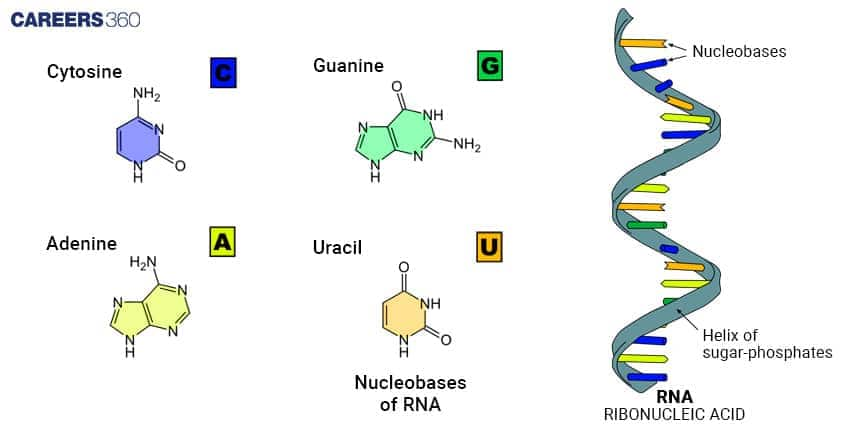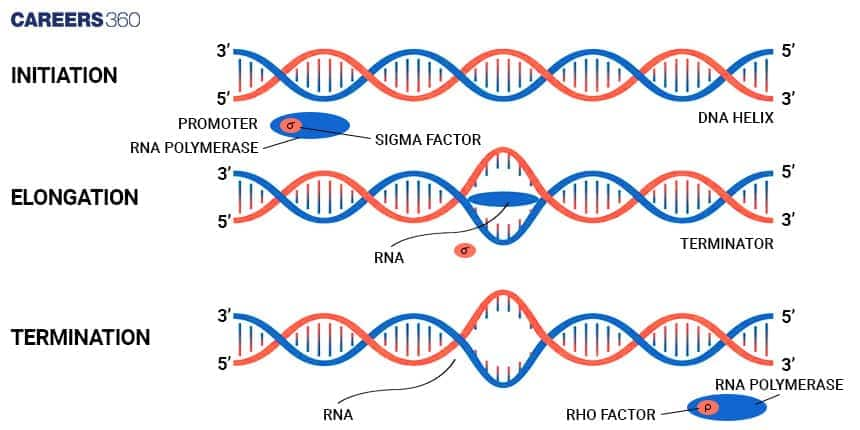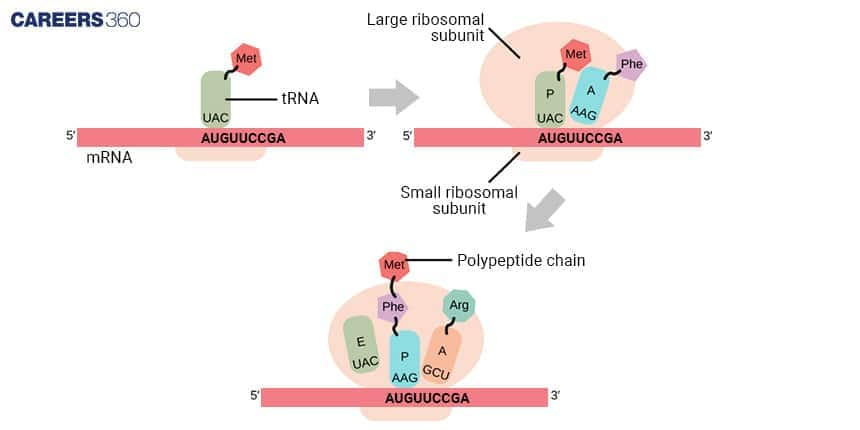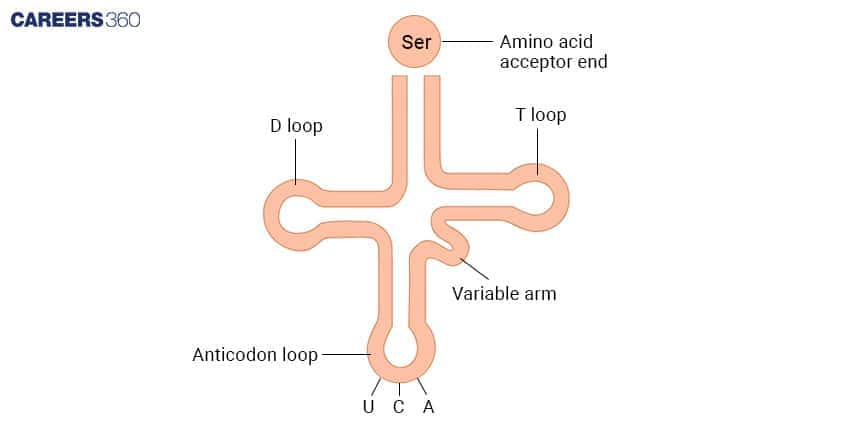RNA: Definition, Structure, Types, Functions, Examples
RNA or ribonucleic acid is an essential molecule found in all living cells. The RNA structure is single-stranded. One of the major differences between RNA and DNA is that RNA contains ribose sugar instead of deoxyribose. The functions of RNA involve protein synthesis and gene expression. RNA is important in the molecular basis of inheritance as it helps pass genetic information.
This Story also Contains
- What Is RNA?
- Structure Of RNA
- Types Of Nitrogenous Bases In RNA
- Types Of RNA
- RNA Functions
- RNA Synthesis (Transcription)
- RNA Translation (Protein Synthesis)
- MCQs on RNA

The functions of RNA are important in translating genetic information into proteins. Messenger RNA (mRNA) carries the genetic code from DNA to the ribosomes. Transfer RNA (tRNA) helps assemble amino acids into proteins. Ribosomal RNA (rRNA) is part of the ribosome's structure and function. These types of RNA work together to ensure efficient gene expression.
What Is RNA?
Ribonucleic acid or RNA is one of the most important biomolecules functioning in the biological universe. RNA acts as the carrier of genetic information. It is involved in the process of genetic coding, decoding, regulation, and manifestation. It is single-stranded and exists in different types. Among them are the messenger RNA (mRNA), the transfer RNA (tRNA), and the ribosomal RNA (rRNA), all of which play different vital roles in protein synthesis and other major biological processes. Unlike DNA, which keeps the information for the more extended future, RNA is involved in more dynamic functions in the cell.
RNA is not as stable and is principally located in the cytoplasm of eukaryotic cells. However, the primary purpose of RNA is to be directly involved in the actual process of translation, or the process of building proteins using the code contained inside the DNA. Such versatility supports the significance of RNA within the gene regulation and gene expression process, thereby reaffirming RNA’s role as a critical component of any organism.
Structure Of RNA
RNA is a type of nucleic acid that carries genetic information. It is generally single-stranded and found in the nucleus as well as the cytoplasm of the cells. RNA acts as genetic material in some viruses. The structure of RNA is discussed below:
RNA is a polymer made up of nucleotides, each consisting of three components:
Ribose sugar
Phosphate group
Nitrogenous base.
RNA has ribose as its sugar. This sugar has a hydroxyl group (OH) at the 2’ carbon of the sugar, making RNA more reactive and less stable than DNA.
The phosphate group links the 3’ carbon of one ribose sugar to the 5’ carbon of the next through a phosphodiester bond, thus forming a backbone that is a sugar-phosphate linkage chain.
Types Of Nitrogenous Bases In RNA
RNA contains four types of nitrogenous bases that store genetic information. These bases are adenine, uracil, cytosine, and guanine. They help in forming the structure of RNA and help in protein synthesis. Each base plays a unique role in the genetic code and RNA functions.
Adenine (A): One of the nitrogenous bases, which, in the transcription and translation process, combines with uracil (U). It is a double-ringed structure in nature.
Uracil (U): A pyrimidine base that substitutes thymine in DNA, forming a pair with adenine (A). It is a single-ring structure and occurs only in RNA.
Cytosine (C): One of the four nitrogenous pyrimidine bases which complement guanine (G). It has only a single ring, and it is involved in the maintenance of stability of different structures of RNA.
Guanine (G): One of the two purines that is complemented with cytosine (C). It has a double-ring structure and is utilised for the formation of stable RNA secondary structures.

Types Of RNA
Different types of RNA perform various roles in the cell. The main types of RNA are mRNA, tRNA, and rRNA, involved in protein synthesis. Other types of RNA help in gene regulation and processing.
Messenger RNA (mRNA)
mRNA helps in translating DNA for protein synthesis. It acts as the bridge between DNA and protein synthesis. It drags messages copied from nuclear DNA to the ribosomal RNA in the cytoplasm. In translation, the ribosomes therefore ‘read’ the mRNA sequence to make proteins in the order the letters of the genetic code were presented to them.
Transfer RNA (tRNA)
tRNA is highly essential in converting the four-letter code from the mRNA into the twenty-lettered amino acids which make up proteins. Every tRNA molecule is tied to one particular amino acid and has its anticodon with the mRNA codons during protein synthesis. This helps in the correct positioning of the amino acids in the forming protein.
Ribosomal RNA (rRNA)
rRNA is an integral part of the organisation of ribosomes, which is associated with the process of protein synthesis. It assists in the pairing of mRNA and tRNA and speeds up the linking of amino acids with peptide bonds. rRNA plays a role in providing support and structural stability to the ribosome and also has a role in the functionality of this biological structure.
Other Types Of RNA
Other types of RNA, like miRNA and siRNA, help in gene silencing by targeting specific mRNA. snRNA is involved in mRNA processing and RNA splicing. These types of RNA control gene expression after transcription. Such functions of RNA are important for proper cellular activities.
RNA Functions
The functions of RNA are essential in the process of gene expression. RNA helps carry the genetic code from DNA to make proteins. RNA helps in the flow of information from gene to protein during protein synthesis. The functions of RNA are discussed below:
Messenger RNA (mRNA)
Role: Copies the genetic information from DNA to ribosome.
Function: Serves as the blueprint on how proteins will be made by ensuring the right order of amino acids in the proteins.
Transfer RNA (tRNA)
Role: Carries specific amino acids to the ribosome during the process of synthesizing proteins.
Function: Has three parts: an anticodon that base pairs with the codons on the mRNA, bringing in the correct amino acid for the polypeptide’s formation.
Ribosomal RNA (rRNA)
Role: Large or small subunit of the ribosomes.
Function: Synthesizes amino acids into proteins by fueling the location where the mRNA and tRNA come together to translate the code.
Other Types Of RNA
MicroRNA (miRNA): It regulates the levels of gene expression by involving specific mRNAs and either promoting their degradation or inhibiting translation.
Small interfering RNA (siRNA): Also like miRNA, it is involved in the RNAi process to suppress the genes' expression or rather their functions.
Small nuclear RNA (snRNA): A protein that is linked to RNA splicing, to ensure the right pre-mRNA is transformed before the RNA is translated into protein.
RNA Synthesis (Transcription)
Transcription is the process in which an RNA molecule is synthesized from a DNA molecule by using the DNA as a template. In eukaryotic organisms, it occurs in the nucleolus, while in prokaryotic organisms, it occurs in the cytoplasm. The most vital ingredient of transcription is RNA polymerase.
Enzymes Involved
RNA polymerase is the enzyme that synthesizes RNA with the help of a DNA matrix. It attaches itself to the DNA at certain sites known as promoters, and then it opens up the furrows of the DNA to reveal the template strand.
Steps In Transcription
Initiation
In this case, RNA polymerase will initially bind to the promoter site with the DNA strand.
The regulator sequence stretches to welcome the gene it promotes, and determines which of the two DNA bases has the function of an RNA base.
Elongation
In RNA polymerase, it works as in DNA polymerase; it synthesizes RNA in the 5’ to 3’ direction.
It pays out the one in front of it and takes up the one behind, repairing each rung by incorporating nucleotides that are, in turn, complementary to the DNA template strand, also known as the antisense strand.
The RNA strand grows as long as the RNA polymerase is within the process of translocation in the DNA molecule.
Termination
Transcription continues until the RNA polymerase gets to the end signal or terminal point of the gene or DNA sequence to be transcribed.
In prokaryotes, termination may be caused by the form/shape of DNA in the RNA, which halts the process abruptly.

RNA Processing
In eukaryotic cells, RNA processing means undergoing essential processing steps to form mature mRNA:
Capping: A 7-methylguanosine cap attached to the 5’ end of pre-mRNA benefits it by shielding it and lending a hand for translation to begin.
Splicing: Excision of introns and linking of exons is carried out by spliceosomes, which are made of snRNPs and proteins.
Polyadenylation: Polyadenylation of the mRNA at the 3’ end also stabilises the mRNA, helps it to export out of the nucleus, and also promotes translation.
RNA Translation (Protein Synthesis)
It is the process by which information in mRNA is translated into a sequence of amino acids that make up a protein. It takes place in the cytoplasm of prokaryotic as well as eukaryotic cells. The role of :
Ribosomes: It should be noted that ribosomes are the organelles where the process of translation takes place. They are made up of two subunits that assemble around the mRNA during translation: large and small.
mRNA: Messenger RNA is responsible for the transportation of the genetic code from DNA to the location known as the ribosome. It holds codons, which are three-nucleotide triplets that will deliver a distinct set of amino acids.
tRNA: It transfers RNA molecules that bring amino acids to the ribosome. Each tRNA has a three-base sequence called an anticodon, and it pairs with the mRNA codon to bring the correct amino acid to the chain that is growing progressively.
Steps In Translation
Initiation
The small ribosomal subunit, with the help of initiation factors, attaches to the mRNA at the start codon, which is AUG.
The first tRNA, which is the initiator tRNA, acquires methionine (N-formyl methionine in prokaryotes) and bonds with the start codon.
Forms a functional ribosome by joining of large ribosomal subunit.
Elongation
Translations also occur in the 5’ to 3 ‘ direction on the mRNA while the ribosome keeps on travelling for the process.
When each mRNA codon of the protein is translated in the process on the A site of the ribosome, corresponding tRNA molecules bring in amino acids.
Protein synthesis, involving the process of peptide bond formation, involves adjacent amino acids linked with the help of a ribosome.
The ribosome shifts so that the next codon of the mRNA is positioned over a new A site of the ribosome, and other tRNAs arrive in the complex.
Termination
Translation proceeds until the RBS is followed by a stop codon – UAA, UAG, or UGA.
Release factors bind to the ribosome and lead to what, and then the polypeptide chain is released from the tRNA in the P site.
The ribosomes say they are done translating the amino acid sequence and pull apart; the newly formed protein emerges.

MCQs on RNA
Question: Which of the following statements is incorrect?
(i) RNA acts as a genetic material as well as a catalyst
(ii) RNA is more stable than DNA
(iii) RNA has evolved from DNA
(i) and (iii) only
(ii) and (iii) only
(i), (ii), and (iii)
(i) and (ii) only
Answer: RNA was the first genetic material. Essential life process—metabolism.
RNA is used to act as a genetic material as well as a catalyst. RNA, being a catalyst, was reactive and hence unstable.
RNA was the first molecule of heredity, so it evolved all the essential methods for storing and expressing genetic information before DNA came onto the scene. However, single-stranded RNA is rather unstable and is easily damaged by enzymes.
Hence, the correct answer is option 2) (ii) and (iii) only.
Question: Read the following statements and choose the ones favouring RNA to be the genetic world in primitive organisms:
A. RNA is stable and rarely undergoes catalytic reactions
B. RNA is reactive and catalytic, which allowed the evolution of DNA from RNA
C. RNA still serves as genetic material in some viruses
D. RNA has no role in carrying the genetic information forward in higher organisms.
1, 2 & 3
2, 3 & 4
2 & 3
3 & 4
Answer: RNA is reactive and takes part in catalysis. As per RNA world hypothesis, it served as genetic material in primitive cells, and still serves as genetic material in some viruses. In higher organisms, it performs the functions of metabolism, translation, splicing, etc.
Hence, the correct answer is option 3) B & C.
Question: Methyl guanosine triphosphate is added to the 5' end of hnRNA in a process of
Splicing
Capping
Tailing
None of these
Answer: A highly important step during the post-transcriptional processing of hnRNA is capping. An uncommon nucleotide termed 7-methylguanylate or the cap structure is attached at the 5' end of the hnRNA. Such a cap is extremely important since it protects the RNA from being broken down by some enzymes. Further, ribosome binding in the process of translation can be efficiently helped by such a cap structure, and lastly, mRNA's exportation into the cytoplasm from the nucleus becomes smooth. Capping is the other necessary step during hnRNA processing, and it prepares for protein synthesis.
Hence, the correct answer is Option (2) Capping.
Also Read:
Frequently Asked Questions (FAQs)
Messenger RNA (mRNA): Helps translate the information encoded in the DNA into commands that can be understood by the ribosome and used for protein synthesis.
Transfer RNA (tRNA): Helps in catalysing the addition of specific amino acids onto the ribosome during the synthesis of protein.
Ribosomal RNA (rRNA): Serves as the skeletal and enzymatic subunit of the ribosome that is involved in protein synthesis.
Other types (e.g., microRNA, siRNA): A part of the general regulatory processes which include RNAsilencing and mRNA degradation.
RNA interference or RNAi is a process that takes place in the biosystem in which RNA molecules block gene expression or translation by binding them or immobilising them. It involves:
Even in the case of dsRNA viruses, the entry of dsRNA into the cell.
The second step through which dsRNA integrates into the post-transcription gene-regulating machinery involves the creation of short interfering RNAs (siRNAs) or microRNAs (miRNAs).
Loading of these small RNAs into RNA-induced silencing complexes abbreviated as RISC.
RISC associated with complementary mRNA sequences, causes degradation of mRNA or suppression of the translation process thus controls gene expression.
Recent advancements in RNA research include: Recent advancements in RNA research include:
Development of RNA-based therapeutics: Such as vaccines based on messenger RNA (mRNA) e. g. COVID-19 vaccines, RNA Interference (RNAi) drugs for inherited disorders, and many more targeting RNA for cancer therapeutics.
RNA modifications and epitranscriptomics: How certain changes in RNA bases for instance methylation affect gene expression and cell functions.
Single-cell RNA sequencing: New opportunities to study the variation of the RNA expression level within a population of cells, which can help in understanding tissue heterogeneity and disease pathogenesis.
RNA nanotechnology: Employing RNA molecules in the generation of nanoscale architectures for drug delivery, diagnostics and biotechnology.
The main role of RNA is to act as a mediator of genetic messages from DNA to the ribosome where it acts as a code for protein synthesis. RNA also has functions in gene regulation, enzyme catalysis and roles in the structure of ribosomes.
A similar case is about the sugar component; RNA contains ribose sugar, on the other hand, DNA contains deoxyribose sugar.
RNA is often single-stranded, though some RNA molecules may be double-stranded while DNA is always double-stranded.
It also includes a base called uracil (U) other than thymine (T) contained in the DNA molecules.
The molecules of RNA are usually smaller and are inactivated faster than DNA; the latter always remains in the nucleus.
